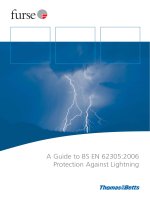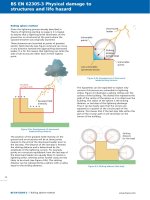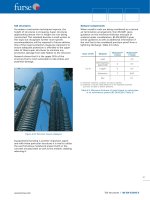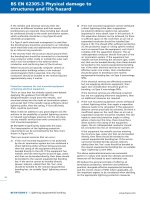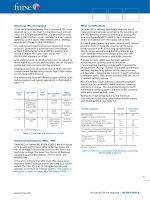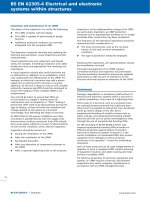Bsi bs en 00627 1996 (1999)
Bạn đang xem bản rút gọn của tài liệu. Xem và tải ngay bản đầy đủ của tài liệu tại đây (263.39 KB, 12 trang )
BRITISH STANDARD
Specification for data
logging and monitoring
of lifts, escalators and
passenger conveyors
The European Standard EN 627:1995 has the status of a
British Standard
BS EN
627:1996
BS EN 627:1996
Committees responsible for this
British Standard
The preparation of this British Standard was entrusted to Technical
Committee MHE/4, Lifts, hoists and escalators, upon which the following
bodies were represented:
Associated Offices Technical Committee
Association of District Councils
British Broadcasting Corporation
British Lift Association
British Railways Board
British Retail Consortium
British Telecom plc
Chartered Institution of Building Services Engineers
Department of the Environment
Department of Trade and Industry
Electrical, Electronic, Telecommunications and Plumbing Union
Engineer Surveyors’ Section of the MSF
Health and Safety Executive
Independent Engineering Insurers’ Committee
Institution of Electrical Engineers
Institution of Environmental Health Officers
Institution of Incorporated Executive Engineers
Institution of Mechanical Engineers
Institution of Plant Engineers
Lloyd’s Register of Shipping
London Underground Ltd.
National Association of Lift Makers
Post Office
Royal Association for Disability and Rehabilitation
This British Standard, having
been prepared under the
direction of the Engineering
Sector Board, was published
under the authority of the
Standards Board and comes
into effect on
15 April 1996
© BSI 03-1999
The following BSI references
relate to the work on this
standard:
Committee reference MHE/4
Draft for comment 92/70281 DC
ISBN 0 580 25128 4
Amendments issued since publication
Amd. No.
Date
Comments
BS EN 627:1996
Contents
Committees responsible
National foreword
Foreword
Text of EN 627:1995
List of references
© BSI 03-1999
Page
Inside front cover
ii
2
3
Inside back cover
i
BS EN 627:1996
National foreword
This British Standard has been prepared by Technical Committee MHE/4 and is
the English langage version of EN 627:1994, Specification for data logging and
monitoring of lifts, escalators and passenger conveyors, published by the
European Committee for Standardization (CEN).
EN 627 was produced as a result of international discussions in which the United
Kingdom took an active part.
Cross-references
Publication referred to
Corresponding British Standard
EN 81-1
BS 5655 Lifts and service lifts
Part 1:1986 Safety rules for the construction and
installation of electric lifts
Part 2:1988 Safety rules for the construction and
installation of hydraulic lifts
BS EN 115:1995 Safety rules for the construction and
installation of escalators and passenger conveyors
a
EN 81-2a
EN 115:1995
a
Undated in the text
A British Standard does not purport to include all the necessary provisions of a
contract. Users of British Standards are responsible for their correct application.
Compliance with a British Standard does not of itself confer immunity
from legal obligations.
Summary of pages
This document comprises a front cover, an inside front cover, pages i and ii,
the EN title page, pages 2 to 6, an inside back cover and a back cover.
This standard has been updated (see copyright date) and may have had
amendments incorporated. This will be indicated in the amendment table on
the inside front cover.
ii
© BSI 03-1999
EUROPEAN STANDARD
EN 627
NORME EUROPÉENNE
August 1995
EUROPÄISCHE NORM
ICS 91.140.90
Descriptors: Lifts, escalators, passenger conveyors, warning systems, remote supervision, defects, data recording, data codes,
numeric codes
English version
Specification for data logging and monitoring of lifts,
escalators and passenger conveyors
Règles pour l’enregistrement de données et la
surveillance des ascenceurs, escaliers
mécaniques et trottoirs roulants
Regeln für Datenerfassung und
Fernüberwachung von Aufzügen, Fahrtreppen
und Fahrsteigen
This European Standard was approved by CEN on 1995-07-13. CEN members
are bound to comply with the CEN/CENELEC Internal Regulations which
stipulate conditions for giving this European Standard the status of a national
standard withour any alteration.
Up-to-date lists and bibliographical references concerning such national
standards may be obtained on application to the Central Secretariat or to any
CEN member.
The European Standards exists in three official versions (English, French,
German). A version in any other language made by translation under the
responsibility of a CEN member into its own language and notified to the
Central Secretariat has the same status as the official versions.
CEN members are the national standards bodies of Austria, Belgium
Denmark, Finland, France, Germany, Greece, Iceland, Ireland, Italy,
Luxembourg, Netherlands, Norway, Portugal, Spain, Sweden, Switzerland and
United Kingdom.
CEN
European Committee for Standardization
Comité Européen de Normalisation
Europäisches Komitee für Normung
Central Secretariat: rue de Stassart 36, B-1050 Brussels
© 1995 All rights of reproduction and communication in any form and by any means reserved to CEN and
its members.
Ref. No. EN 627:1995 E
EN 627:1995
Foreword
Contents
This European Standard has been prepared by
Technical Committee CEN/TC 10, Passenger, goods
and service lifts, of which the secretariat is held by
AFNOR.
This European Standard shall be given the status of
a national standard, either by publication of an
identical text or by endorsement, at the latest by
February 1996, and conflicting national standards
shall be withdrawn at the latest by February 1996.
This European Standard has been prepared under a
mandate given to CEN by the European
Commission and the European Free Trade
Association, and supports essential requirements of
EC Directive(s).
According to the CEN/CENELEC internal
regulations, the following countries are bound to
implement this European Standard: Austria,
Belgium, Denmark, Finland, France, Germany,
Greece, Iceland, Ireland, Italy, Luxembourg,
Netherlands, Norway, Portugal, Spain, Sweden,
Switzerland and United Kingdom.
Foreword
Introduction
1
Scope
2
Normative references
3
Definitions
4
Data logging
5
Monitoring and reporting
6
Hardware
Annex A (normative) Tables
Table A.1 — Code number allocation
Table A.2 — Fault codes for lifts
Table A.3 — Event codes for lifts
Table A.4 — Alarm code for lifts
Table A.5 — Fault codes for escalators and
passenger conveyors
Table A.6 — Event codes for escalators and
passenger conveyors
2
Page
2
3
3
3
3
3
4
4
5
5
5
5
6
6
6
© BSI 03-1999
EN 627:1995
Introduction
The provisions for data logging and monitoring
contained in this standard are distinct from the
safety requirements laid down in EN 81-1, EN 81-2
and EN 115.
The standard describes methods of, and systems for,
registering information with regard to the status of
the lift, escalator or passenger conveyor
installation. This information is intended as an aid
to servicing and may be applied to single or multiple
installations.
1 Scope
This European Standard specifies the fundamental
characteristics of data logging and monitoring
systems for lift, escalator and passenger conveyor
installations.
2 Normative references
This European Standard incorporates by dated or
undated reference, provisions from other
publications. These normative references are cited
at the appropriate places in the text and the
publications are listed hereafter. For dated
references, subsequent amendments to or revisions
of any of these publications apply to this European
Standard only when incorporated in it by
amendment or revision. For updated references the
latest edition of the publication referred to applies.
EN 115:1995, Safety rules for the construction and
installation of escalators and passenger conveyors.
EN 81-1, Safety rules for the construction and
installation of lifts and service lifts —
Part 1: Electrical lifts.
EN 82-1, Safety rules for the construction and
installation of lifts and service lifts —
Part 2: Hydraulic lifts.
3 Definitions
For the purposes of this standard the relevant
definitions of EN 81-1, EN 81-2 and EN 115,
together with the following definitions, apply:
3.1
alarm
the monitoring of the operation of the emergency
alarm device specified in EN 81-1 and EN 81-2
3.3
event
any occurrence within an installation, envisaged in
the installation design, which is not a malfunction
but which may cause a degradation of, or
interruption to, the normal operation of the
installation
3.4
fault
a malfunction within the installation which may
cause a degradation of, or interruption to, the
normal operation of the installation
3.5
installation
one or more lifts which operate as a group, a single
escalator or a single passenger conveyor
3.6
monitoring equipment
equipment connected to, and which interrogates,
the data logging equipment for the purpose of
displaying fault and/or event information derived
from the data recorded by the data logging
equipment
3.7
on-site equipment
equipment connected to the installation or the data
logging equipment connected thereto via dedicated
communication links not shared with other
installations or equipment
4 Data logging
The faults, alarms and events recorded by the data
logging equipment shall be identified by the
relevant code numbers listed in Table A.1 to
Table A.6 and the time and date of occurrence. The
first two digits of the code number shall be used for
the fault/alarm/event family and might be
sufficient. A further two digits, shown as two
asterisks in Table A.2 to Table A.6, may be allocated
for the sub-identification of faults, alarms or events.
These codes shall not be used for any other purpose.
NOTE One malfunction, or event, in the installation may result
in several codes being recorded.
The recorded time and date shall be that dictated by
the data logging equipment’s internal clock.
3.2
data logging equipment
equipment which extracts and records by time and
date, either permanently or temporarily, or both,
data relating to the operation availability of an
installation, i.e. faults, alarms and events
© BSI 03-1999
3
EN 627:1995
5 Monitoring and reporting
6 Hardware
5.1 All the communication equipment associated
with the installation shall carry the appropriate
approval and, as far as possible, be located within
the bounds of the installation.
The monitoring equipment can be located in the
machine room, outside the machine room (a remote
point) or in both.
5.2 The on-site equipment shall be capable of
automatically communicating the faults, alarms
and events selected from the Table A.2 to Table A.6.
5.3 The on-site equipment shall be capable of
communicating with one or more remote points.
5.4 It shall be possible to communicate with the
on-site equipment from a remote location in order to
produce the current status of the installation and
obtain a data read out.
A security system, e.g. password, shall be provided
in order to control the communication link.
Should a fault or alarm occur during a readout the
fault or alarm shall override the read out.
5.5 Several installations may be connected to a
central point via a single communication link.
5.6 If a communication link is not kept under the
control of the data logging installation, a minimum
amount of data shall be maintained at source. This
minimum amount of data should be at least the ten
most recent reports (a total of faults, alarms and
events).
6.1 Back-up shall be provided to maintain data for a
minimum period of 8 h.
6.2 If the signal of the emergency alarm device
specified in EN 81-1 and EN 81-2 is communicated
via the data logging and monitoring equipment, the
alarm function transmission capability shall be
maintained for a minimum of 1 h after a power
supply failure.
6.3 Connection or failure of the data logging
equipment shall not compromise conformity of the
installation to the safety rules specified in the
relevant European Standards.
4
© BSI 03-1999
EN 627:1995
Annex A (normative)
Table A.1 — Code number allocation
Lifts
Table no.
Fault
Alarm
Event
Used
a
Reserved
Table A.2 00-13
Table A.4 90
Table A.3 40-46
14-24
91-94
47-54
Escalators and passenger conveyors
b
Optional
25-39
95-99
55-59
c
Table no.
Useda
Table A.5 60-64
—
—
Table A.6 75-78
Reservedb
65-69
—
79-84
Optionalc
70-74
—
85-89
a
Codes which are prescribed in Table A.2 to Table A.6 of this standard.
Codes which are reserved for future additions to this standard.
c Codes which are available for use freely outside the allocated used and reserved codes of this standard.
b
Table A.2 — Fault codes for lifts
Code No
Faults
00**
No faults recorded
01**
Safety circuits interrupted
02**
Lock circuit interrupted whilst running
03**
Failure of normal door closing sequence
04**
05**
Car stopped outside door unlocking zone
Stuck call button
06**
07**
08**
09**
Lift failed to start
Low voltage on the lift logic supply
Not allocated
Failure of the self-test procedure
10**
Run-time limiter operated
11**
12**
13**
Position lost
Excessive temperature of drive system
Failure of normal door opening sequence
Explanatory notes
All faults in the data logging equipment have
been cleared
Any safety switch open (e.g. slack rope,
overspeed, door lock, etc.)
Break in landing or car door safety circuit
while lift is running (tipped lock)
Door failing to close within a defined
parameter
Any car or landing call which continues to
remain registered, after the car has stopped
at that floor, for more than a specified time
Power supply unit out of specification
Failure of car movement by an automatic call
at regular interval if fitted
Next floor door zone not seen within specified
time (see 10.6.2.2 of EN 81-1 or 12.12 of
EN 81-2)
Lift position re-set occurred
Door failing to open within a defined
parameter
Table A.3 — Event codes for lifts
Code no.
Events
40**
No events recorded
41**
42**
43**
44**
Main lift supply switched off
Inspection control mode
Fire service mode
Data logging OFF
45**
Car preference mode
46**
Emergency power operation
© BSI 03-1999
Explanatory notes
Car returned to normal service or all events
in data logging equipment cleared
Mains supply not available
Records when data logging is inhibited and
when engineer is on site (see 90**)
The operation of the lift is such that it does
not respond to landing calls
5
EN 627:1995
Table A.4 — Alarm code for lifts
Code no.
90**
Alarm
Alarm button pressed
Explanatory notes
Not inhibited by 44**
Table A.5 — Fault codes for escalators and passenger conveyors
Code no.
Faults
Explanatory notes
60**
No faults recorded
All faults in the data logging equipment have
been cleared
61**
Safety circuit interrupted
Any safety switch open (e.g. step sag,
handrail brake)
62**
Control voltage failure
63**
Comb switch operated
64**
Excessive motor temperature
Table A.6 — Event codes for escalators and passenger conveyors
Code no.
Events
Explanatory notes
75**
No events recorded
Escalator returned to normal service or all
events in data logging equipment cleared
76**
Main supply switch off
Mains supply not available
77**
Inspection control mode
78**
Emergency stop operated
6
© BSI 03-1999
BS EN 627:1996
List of references
See national foreword.
© BSI 03-1999
BSI
389 Chiswick High Road
London
W4 4AL
|
|
|
|
|
|
|
|
|
|
|
|
|
|
|
|
|
|
|
|
|
|
|
|
|
|
|
|
|
|
|
|
|
|
|
|
|
|
|
|
|
|
|
|
|
|
|
|
|
|
|
|
|
|
|
|
|
|
|
|
|
|
|
|
|
|
|
|
|
|
|
|
|
|
|
|
|
|
|
|
|
|
|
|
|
|
|
|
|
|
|
|
|
|
|
|
|
|
|
|
|
|
|
|
|
|
|
|
|
|
|
|
|
|
|
|
|
|
|
|
|
|
|
|
|
|
|
BSI Ð British Standards Institution
BSI is the independent national body responsible for preparing British Standards. It
presents the UK view on standards in Europe and at the international level. It is
incorporated by Royal Charter.
Revisions
British Standards are updated by amendment or revision. Users of British Standards
should make sure that they possess the latest amendments or editions.
It is the constant aim of BSI to improve the quality of our products and services. We
would be grateful if anyone finding an inaccuracy or ambiguity while using this
British Standard would inform the Secretary of the technical committee responsible,
the identity of which can be found on the inside front cover. Tel: 020 8996 9000.
Fax: 020 8996 7400.
BSI offers members an individual updating service called PLUS which ensures that
subscribers automatically receive the latest editions of standards.
Buying standards
Orders for all BSI, international and foreign standards publications should be
addressed to Customer Services. Tel: 020 8996 9001. Fax: 020 8996 7001.
In response to orders for international standards, it is BSI policy to supply the BSI
implementation of those that have been published as British Standards, unless
otherwise requested.
Information on standards
BSI provides a wide range of information on national, European and international
standards through its Library and its Technical Help to Exporters Service. Various
BSI electronic information services are also available which give details on all its
products and services. Contact the Information Centre. Tel: 020 8996 7111.
Fax: 020 8996 7048.
Subscribing members of BSI are kept up to date with standards developments and
receive substantial discounts on the purchase price of standards. For details of
these and other benefits contact Membership Administration. Tel: 020 8996 7002.
Fax: 020 8996 7001.
Copyright
Copyright subsists in all BSI publications. BSI also holds the copyright, in the UK, of
the publications of the international standardization bodies. Except as permitted
under the Copyright, Designs and Patents Act 1988 no extract may be reproduced,
stored in a retrieval system or transmitted in any form or by any means ± electronic,
photocopying, recording or otherwise ± without prior written permission from BSI.
This does not preclude the free use, in the course of implementing the standard, of
necessary details such as symbols, and size, type or grade designations. If these
details are to be used for any other purpose than implementation then the prior
written permission of BSI must be obtained.
If permission is granted, the terms may include royalty payments or a licensing
agreement. Details and advice can be obtained from the Copyright Manager.
Tel: 020 8996 7070.

